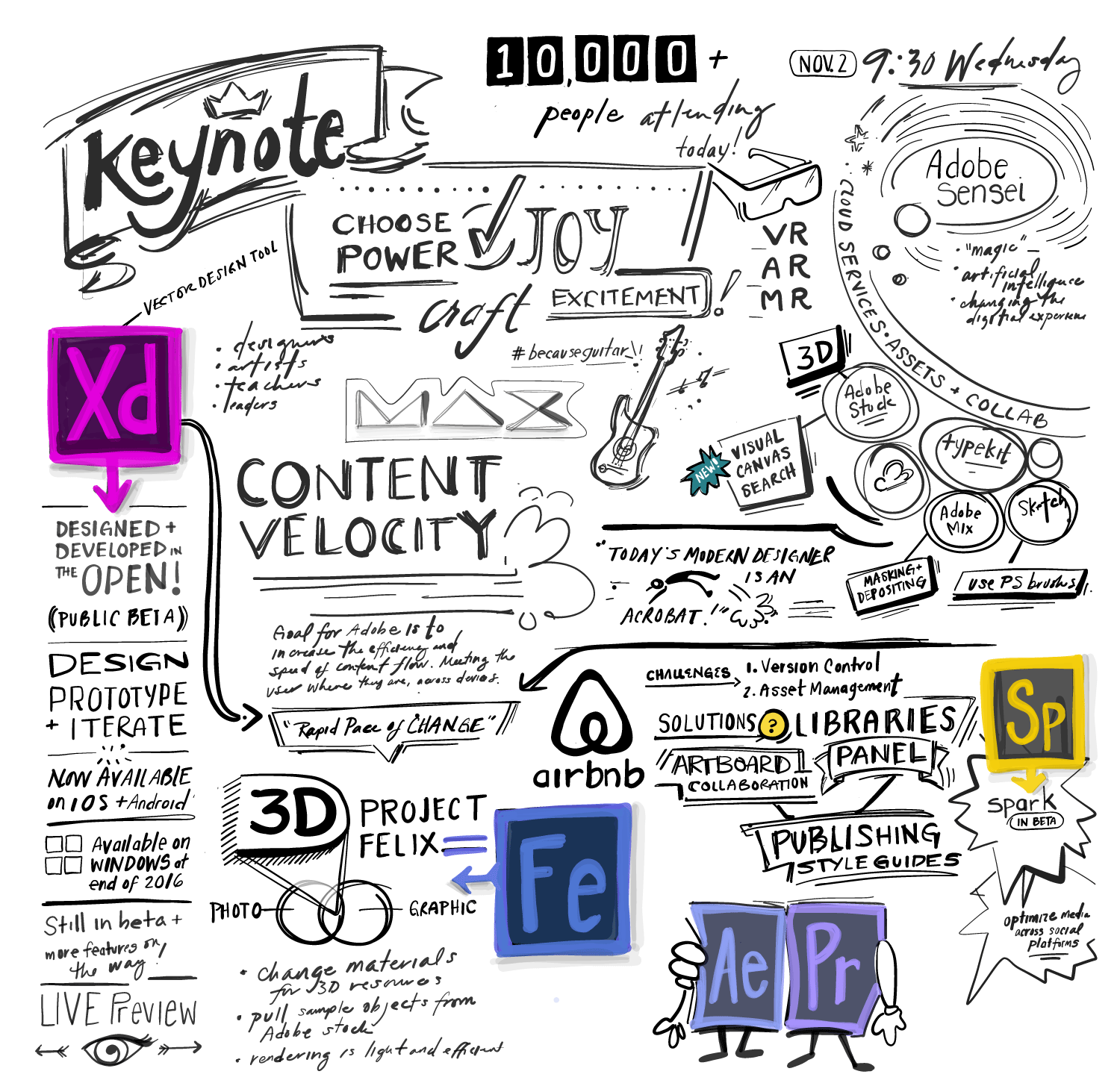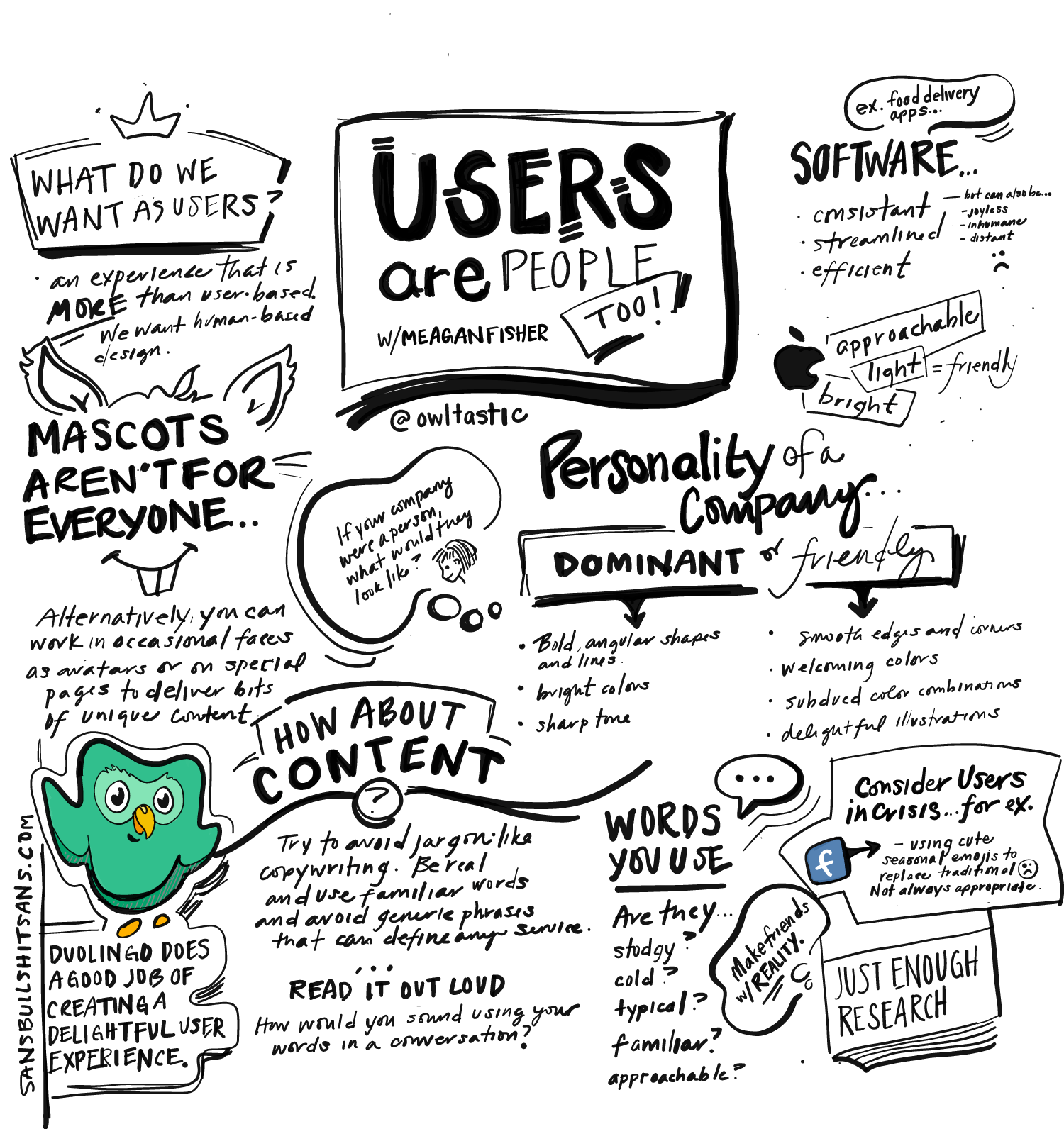Late last year, I found myself in San Diego sitting with a few colleagues in a massive event space. We were about to witness the first keynote of a creative conference called Adobe MAX. Define “massive”? Okay, I’m fairly confident the majority of the attendees were present for this particular talk in the conference schedule, and the rows of chairs went far beyond the distance of what I would perceive to be the other end of a football field. We were excited to get started as hundreds of professionals entered the room. For us creative folk, outside of festivals like SXSW and HOW, MAX is one of the events we’re looking forward to all year.
Ready to rock and roll, my co-workers and I were able to find great seats near an aisle in the middle of the room, and began working through what would be the routine of extracting all of the gadgets required to capture the invaluable thought leadership ahead of us. Camera? No, not that lens, this one is better for the wide stage. Where’s my phone? Has someone started a hashtag for the event? Who’s tweeting about the presenters? Snap! Snap! This place is huge, and attendees are still rolling in. There’s going to be so much great content…
“Where did I put my notebook?”
This was the moment I remembered reading about my first experience with Sketchnotes. This is a visual method of note taking allows you to prioritize the material you’re taking in and record it in a way that is easy to scan and digest when you’re ready to revisit it later. I figured this would be as good of an opportunity as any to give this method a try. If it didn’t work well for me, I could easily revert to a more traditional style – bullets, short clauses, etc.
How did it go?

So, instead of firing up Evernote on my iPad and typing my notes that way, I opened a sketching app, pulled out my Apple Pencil and began with a combination of drawing and writing down the larger concepts being presented on the stage. I found that it was fun to come up with containers and shapes to support the keywords and thoughts I wanted to highlight and remember upon revisiting the page. As I worked across the empty screen, I started to create a rhythm of capturing the big ideas I wanted to remember, and using the time in between the major points cleaning up the sketch work so it would be easier to read upon returning to the page. I found that it was easier to focus on the presentations overall since I wasn’t spending the effort working to write bullets covering everything that was being shared. Changing how I recorded the information changed how I listened to the delivery. Instead of burying my eyes in my notebook, sketching creating several natural pauses that allowed me to better listen to the material. I later found that for the presentations I elected to sketch the notes out, I retained more of the message. Somehow, using the more visual method of recording created a more concrete interpretation of the session experiences.
For me, it worked out well! I was happy to return home with a collection of solid composites, all recorded in a way that would be interesting and clear for me to digest later on. I’m glad I made the decision to skip my typical note-taking method, and explore a new-to-me format.
I want to share 3 ways to help you determine if taking Sketchnotes is right for your situation:
1 / Who are your notes for?
I’m guessing if you’re a pro in the digital space, you’ve taken some variety of notes at a conference, while listening to a podcast, or even during a training session. Do you typically share those notes with a team? Do you use them to help you draft outlines for articles? How about simply to assimilate a new topic for inspiration? For myself, I find that it’s helpful to identify my intentions with my note-taking. It helps me to figure out which format I should use, and in this instance, I knew that I wanted to capture these upcoming talks in a way that would be memorable, personal, and relevant. From experience attending previous industry talks and similar events, I learned that it is easy to be swept away by the all of the amazing material I would soon collect from session to session, and I wanted to be mindful that for each talk, my goal would be to capture each experience in a way that would make the most sense to me.
2 / How much time do you have?
With something like a conference, you’re likely going to have handy a way to capture photos and a way to record your ideas and/or thought leadership from your sessions. I personally like having my phone and tablet within reach, so realistically I’ve found that I need no more time to dig into taking notes this way than in a traditional way. All you need is to open your notebook and get started. Though for me personally, I find that they work best when I’m listening/watching a presentation as opposed to during a quick chat with a co-worker, for example.
3 / What materials are you working with?
Pen and paper? iPad and Pencil? Note and stylus? Regardless of the medium, so long as you have something that is easy for you to make a simple mark on a surface, you’ve got what you need to start taking sketchnotes.

But are they actually helpful… Or are they simply a party on a page?
The first time I came across an article on sketchnoting, I was curious if they actually help you to retain what you’re wanting to take away from your discussion or lecture. I figured the only way to know for sure was to try it out, and I find that I tend to go this route whenever I have the chance. It’s become my favorite way to take notes for a few reasons…
One of the ways I’ve found this format to be helpful is when I’m looking back at the material later for distinctive concepts from the session. I’ve found that when returning to a set of notes that I’ve drawn, it’s easier for me to pick out the concepts on the page that I found most impactful. This benefit makes it quicker and more effective to dissect and assimilate the content I recorded.
Another benefit I discovered during the actual note-taking process. As I mentioned before, giving the thoughts interesting shapes, containers, colors, and distinctive type definition better-cemented the ideas in my memory. Just like jotting something down in a passing conversation can give the thought a bit more permanence, drawing it out with other ideas in context of the conversation only enhances that trick!
Drawing my thoughts out in an open space also gives me more control over how I connect the points being delivered in a presentation. Instead of being restricted by a vertical list or grid setup, I can group similar ideas in any way I’d like in any space that fits!
Some additional thoughts about visual note taking:
It can be a fun tool for networking. i’ve made several connections over the years at events where my taking notes created an indirect ice breaker for conversation around the presented topic, and the Sketchnotes themselves. Sometimes, I work in contact information or conversation bullets I had with a new connection directly onto the page.
This format is not just for illustrators… Everyone can draw! The concern I hear the most when sharing the idea of Sketchnotes with someone is about whether or not you need to draw well. Naturally, if you like to draw and doodle, this practice will be a fluid experience for you. But, the characters, ideas, and shapes don’t need to be polished in order to have an impact. Part of the work is done with the act of putting pen to paper! If the notes are for YOU, and they are clear and easy to understand when you return to them, you’ve done a great job. So long as the experience was engaging and memorable for you in the long run, that’s all that matters.
CREDIT
A Guide to Visual Note Taking
The Designer Who Coined the Term “Sketchnotes”
